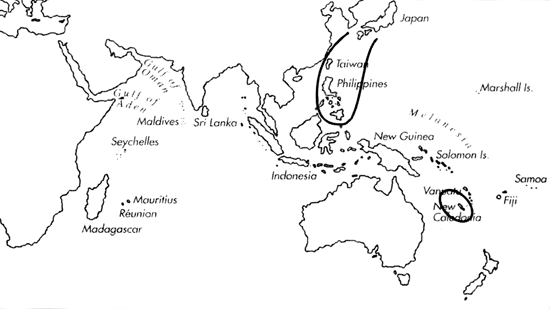Range: Japan to Philippines; Chesterfield Is. and New Caledonia.
Description: Small and light. Last whorl narrowly conical to conical; outline straight to slightly concave. Shoulder carinate, occasionally slightly undulate. Spire of low to moderate height, outline concave. Larval shell of 3.5-3.75 whorls, maximum diameter 0.8-0.9 mm. First 0.5-3 postnuclear whorls tuberculate to undulate. Teleoconch sutural ramps flat to concave, with 0-4 increasing to 3-6 spiral grooves crossed by fine arcuate radial threads. Last whorl glossy and smooth, except for about 9- 12 spiral ribs at base and 4-6 fine spiral grooves below shoulder.
| Shell Morphometry | ||
|---|---|---|
| L | 16-23 mm | |
| RW | - | |
| (< 0.06 g/mm) | ||
| RD | 0.46-0.54 | |
| PMD | 0.85-0.97 | |
| RSH | 0.09-0.16 | |
Colour pink to orange, usually except for white shoulder area and white teleoconch spire. Last whorl with 9-16 reddish brown spiral lines. Rectangular or irregular brown blotches arranged between spiral lines, producing 3 "brickwall" bands, below shoulder and on each side of centre; upper band may be absent. Larval whorls brownish grey. Postnuclear sutural ramps with large brown radial blotches extending over shoulder, darker at their outer margins. Aperture translucent.
Periostracum olive, thin, translucent, and smooth on last whorl, opaque and with arcuate radial ridges on sutural ramps.
Habitat and Habits: Habitat and Habits: In 120- 250 m.
Discussion: C. kimioi resembles C. pseudokimioi. For comparison, see the Discussion of that species.

C. kimioi range map
This section contains verbatim reproductions of the accounts of 316 species of Conus from the Indo-Pacific region, from Manual of the Living Conidae, by Röckel, Korn and Kohn (1995). They are reproduced with the kind permission of the present publisher, Conchbooks.
All plates and figures referred to in the text are also in Röckel, Korn & Kohn, 1995. Manual of the Living Conidae Vol. 1: Indo-Pacific Region.
The range maps have been modified so that each species account has it own map, rather than one map that showed the ranges of several species in the original work. This was necessary because each species account is on a separate page on the website and not confined to the order of accounts in the book.